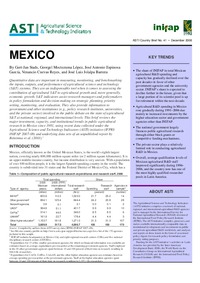Authors:
Stads, Gert-Jan; López, Georgel Moctezuma; Espinosa García, José Antonio; Cuevas Reyes, Venancio; Barrera, José Luis Jolalpa
Year:
2008
Publisher
International Food Policy Research Institute (IFPRI); and National Institute for Forestry, Agricultural, and Animal Husbandry Research (INIFAP)
Back to:
Total public agricultural R&D capacity in Mexico has gradually increased over the past two decades. In 2006, the country as a whole employed more than 4,000 fte agricultural research staff, making it the second largest agricultural R&D system in Latin America after Brazil. The institutional structure of the country’s agricultural R&D, however, has become increasingly diversified. Since the early 1990s, research staff increases were observed for the higher education sector and government agencies other than INIFAP, whereas totals at INIFAP have continuously declined. The latter suffered a particularly severe blow in December 2007 when the Mexican government announced a voluntary early retirement scheme and INIFAP lost 280 scientists virtually overnight. The average age of INIFAP’s current researcher pool is 52, meaning that many more scientists are up for retirement within the next decade.
Total agricultural R&D spending in Mexico has risen gradually since the early 1990s, due mainly to increased investments by the higher education sector and government agencies other than INIFAP. In 2006 Mexico invested $518 million (in constant 2005 PPP prices) in agricultural R&D, or 1.27 percent of the country’s agricultural output. A similar shift was seen in the composition of Mexico’s public agricultural research spending, with other government agencies and the higher education sector gradually gaining prominence at the expense of INIFAP.
Agricultural R&D in Mexico is largely financed by the national government, with SAGARPA allocating funding to the main agricultural universities and INIFAP receiving funding directly through SHCP. The private sector funds some of the research activities of INIFAP, ColPos, and UACh, but the sector seems to favor contracting with internationally renowned institutes like Tecnológico de Monterrey and CINVESTAV for its research needs. In recent years, a number of competitive funds (at the national, state, and sector level) have become increasingly important in financing agricultural R&D.
Overall, the Mexican public agricultural R&D system appears to be adequately staffed and financed when compared to other countries in the region and developing countries worldwide. However, the very large number of agricultural R&D agencies scattered over the country, often with only a handful of research staff and overlapping research mandates, has made Mexico’s agricultural research system somewhat weak and ineffective. It has also created a climate in which a few well-funded agencies producing world-class research operate alongside less productive agencies that are struggling for funding. Greater economies of scope and scale may be achieved if the agricultural R&D agencies in Mexico continue to better integrate their research efforts. A more effective distribution of agricultural research funding and a clear long-term national research strategy that involves both the public and private sector would contribute to this goal.

